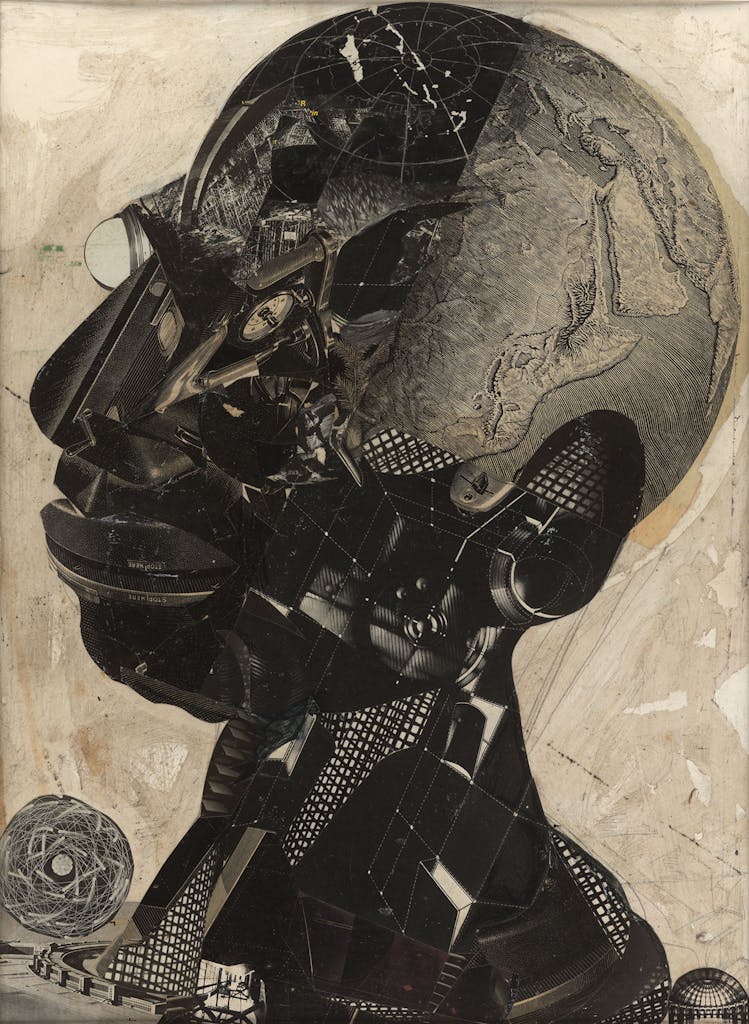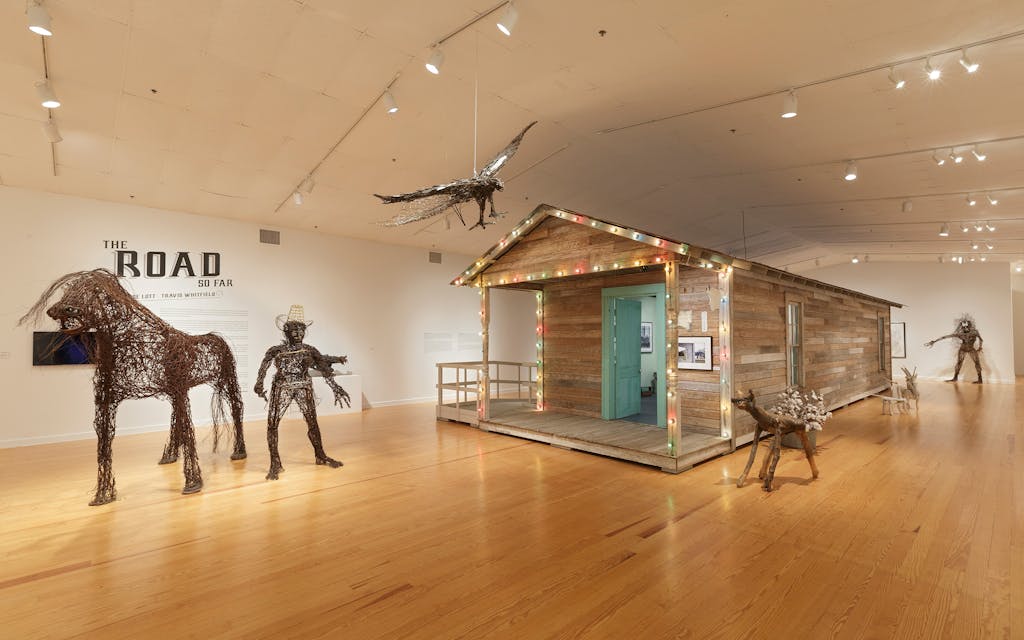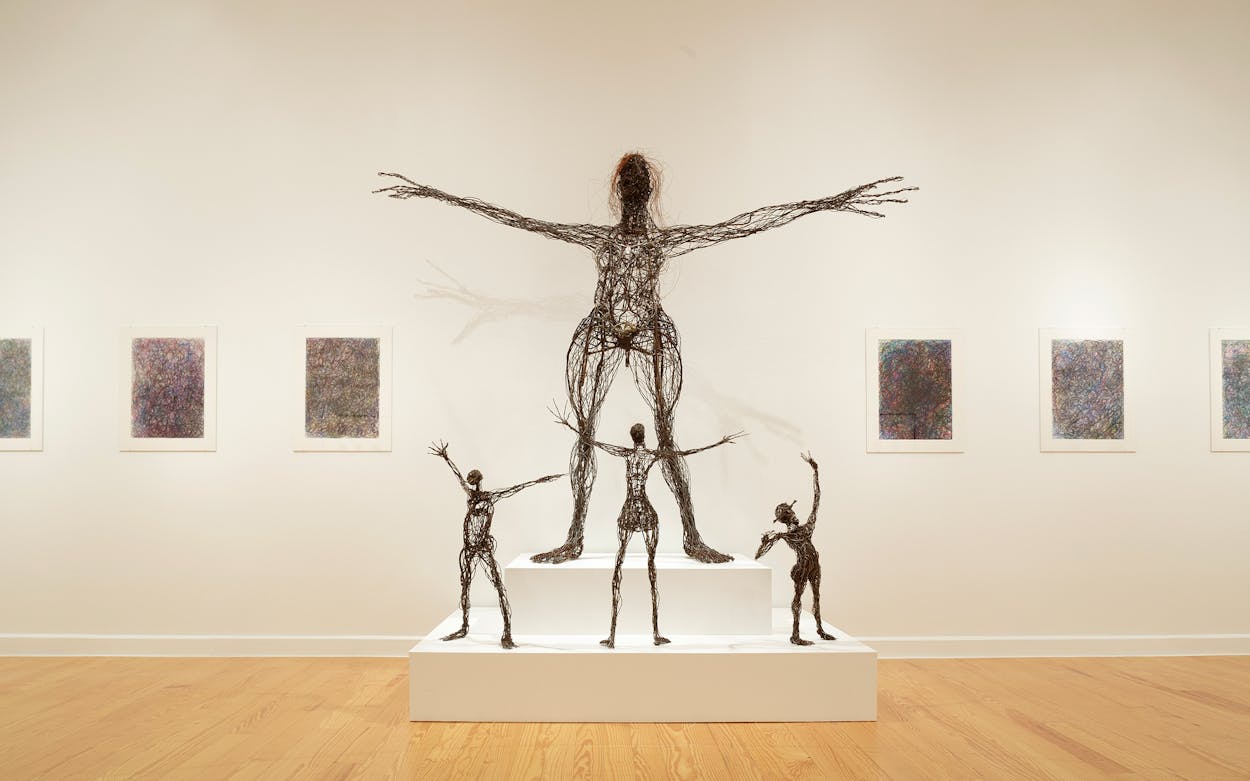If a single work by the Houston artist Jesse Lott best represents his approach to making art, it is perhaps one of his earliest pieces, Collage Man, from 1965. The black and white image, roughly two by three feet, depicts a man’s silhouette pieced together from bits of mechanical renderings, architectural photographs, and, most notably, a vintage topographical engraving of the Earth with Africa in the foreground. This last comprises the back of the figure’s head, suggesting a natural wellspring of all the mechanical inventions that make up the figure’s face. Collage Man reads instantaneously as archetypal—this isn’t one man’s head, it is Everyman’s. It is a global whole far greater than the sum of its many parts.
Jesse Lott is a magpie artist who assembles his work from odds and ends, whether found images in his collages or detritus from what he calls the “urban frontier” in his sculptures, which are the works for which he is probably best known. In these sculptures, Lott weaves pieces of junk, discarded furniture, driftwood, and huge lengths of rusty wire into wild, evocative figures of humans and animals.
Many of these sculptures are on view in “The Road So Far,” a two-person exhibition (with Louisiana artist Travis Whitfield) on view at the Station Museum of Contemporary Art in Houston through September 5. The show fills the cavernous Station building with more than sixty works by Lott spanning three decades, surrounding a full-scale shotgun house by Whitfield in the center of the main gallery.

Lott was recently named the Texas state three-dimensional artist for 2022, in honor of his wire and papier-mâché sculptures. He is sometimes mistaken for a folk artist because his scrappy materials, from junkyards or found on the street, suggest a kinship with important self-taught artists like Lonnie Holley or Hawkins Bolden. But Lott is a professionally trained artist who has deliberately chosen to make the urban frontier both his material and his subject matter. “He knows exactly what he’s doing,” says the Houston art historian and writer Pete Gershon.
As a young man, Lott left Houston, first for Hampton University in Virginia and then for Los Angeles, where he studied at the Otis Art Institute under Charles White, the legendary artist, draftsman, and teacher to such notable artists as David Hammons and Kerry James Marshall. In a 2018 documentary by Houston filmmaker Cressandra Thibodeaux, Lott says he learned about art concepts from the Houston artist John Biggers, but he learned about technique from White.
Lott’s technique is on full display at the Station in his confident ink drawings, which provide the biggest surprise and pleasure of the exhibit. In dozens of drawings both large and small, Lott tirelessly explores line, one of the most fundamental elements of art. Lines in visual art (as in all art—think lines of music or literature) are about connection, through space as well as time. And every one of Lott’s drawings evince a hand patiently moving over the page repetitively, for hours, leaving hundreds of trails behind.
The drawings are composed of many lines of color layered over one another, arcing and looping, with the brightest colors often emerging through a darker foreground, making the pages seem lit from within. Many of the drawings appear purely abstract, although they have evocative titles like Big Blue Night, Summer Heat, or Golden. In other works, faces and bodies are discernable. The artist Rick Lowe, Lott’s longtime colleague and the cofounder of Houston’s Project Row Houses, likens Lott’s fluid approach in his drawings to his sculptures: “He’ll find a piece of wood and he’ll play with it until maybe there’s a figurative form that will reveal itself. So all those ink drawings are on the verge of becoming figurative on some level.”
Take Summer Heat. Anyone who has experienced a midsummer day in Houston will recognize the shimmering oppressiveness of the drawing, in which a field of thin neon green, orange, and yellow lines is overlaid with darker blues and blacks, suggesting the view of someone who has retreated to a spot of shade on a blazing afternoon. Lott’s signature swirling lines are slashed through with jagged, vigorous hatch marks, which together suggest humans, insects, and greenery in a dense, humming mass of intense heat and humidity. By contrast, his drawing Big Blue Night is all curving sensuality, evoking Van Gogh’s Starry Night with its darkened swirls interspersed with a few hints of yellow.
In one of my favorite drawings in the show, On the Backs of Giants, Lott does not fill the entirety of the paper, but patiently assembles a layered, mountainous form that triumphantly rises up from the center of the page. The luscious images at the Station are all the more remarkable for having been made with everyday ballpoint pens and markers.

Lott’s wire sculptures are an extension of his interest in line. The artist Mel Chin, who, like Lott, grew up in Houston’s Fifth Ward, and who counts Lott as a longtime friend, remembers that “Jesse was always drawing, where the line became the wire, and the wire became the line.” Lines made of wires are integral to his sculptures, in their sinewy, outstretched limbs and hair—especially the electric jolt atop the demonic, life-size Fire Spitter, a female figure that is a highlight of the show. Lott inserts found bits of metal and glass to the basic wire framework of his figures, making innovative use of such items as an old metal watchband for teeth, or of a pair of face guards from football helmets for a woman’s hips.
Lott’s wire sculptures are like medical models of a body’s underlying structure of bone and sinew, but occasionally he adds flesh and clothes to that structure in his humorous papier-mâché figures, a few choice examples of which are on view at the Station. In addition, several of Lott’s mythological beasts made of furniture parts are included in the show. Chin describes encountering these creatures one day long ago during a visit to Lott’s famously cluttered studio: “They were lurking or crouching within all the debris. They were almost camouflaged in the junk.” Divorced from their original studio habitat and presented on pedestals in a gallery setting, these wooden creatures assembled from parts of chairs and tables become relics or totems, infused with symbolism that transcends whatever utilitarian function the furniture might have once served. Or, as Lott put it to me recently in describing one of these works, “Instead of being what it does, it becomes what it looks like.”
Lott has often described the work of an artist as the manipulation of matter. He says that artists do not create; rather, they perceive the landscape around them for the opportunities it provides. In Lott’s own manipulation of the urban frontier of Houston, he changes the symbolic nature of things that would otherwise be disregarded or thrown away. Regarding the role of the artist in society, he explains, “There’s some reason human beings think art is very important. It occupies a place in our mind, it occupies a place in our economy. There has to be a reason for that. And when you’re discovering the reason, then you find the real meaning of creative expression.”
That expression is evident in Lott’s own work, but also in his longtime mentorship of people in Houston’s Fifth Ward, where he has maintained his practice while introducing many members of the community to art. Rick Lowe describes this facet of Lott’s work: “He’s concerned with people who are making art as not an academic thing. It’s something that is somehow deeply connected and rooted in the spirit of the person. And so finding people on the street, people in the neighborhood, and introducing them to art and mentoring them, that’s where his mentorship to me really starts to shine the most.”






